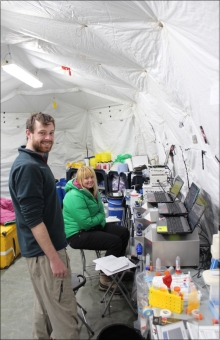When we breathe in air, the oxygen within it begins a journey. It travels down our trachea and into the lungs, where it passes into the bloodstream. The heart then pumps the blood all around our body, so that the oxygen is distributed to every single cell. Each of these contains hundreds of tiny organelles called mitochondria, the �powerhouses� of the cell. These are the final acceptors of oxygen, and they use it to convert fuels such as sugars and fats into the energy that keeps us alive and is essential for every single process in our body.
Our primary role as investigators on Xtreme Everest 2 is to try to understand what happens to these sub-cellular engines when oxygen becomes limited. As the final consumers of oxygen, changes in how they function might explain some aspects of acclimatisation to altitude. Also, it�s possible that Nepalese Sherpas possess mitochondria that process oxygen more efficiently, enabling them to cope better with high altitudes.
It is this idea which has driven us to come to Everest Base Camp to conduct our research. We take small pieces of muscle from both lowlander and Sherpa subjects. Then, we make holes in the surface of the cells to gain access to the mitochondria, while keeping them alive. The mitochondria are fed with fats and carbohydrates, and we can then measure their oxygen usage using specialised equipment called oxygraphs, kindly donated by Oroboros Instruments for the project.
Running this project in such a harsh environment (in comparison to a warm, cosy lab in Cambridge!) is far from easy. Lots of delicate equipment and a variety of chemicals have been transported up the mountain by yaks and porters. Temperatures in the lab have ranged from -20°C in the morning, to +20°C in the afternoon, which is a struggle for such sensitive experiments. We�ve had to improvise at times, tissue has been kept cold on glacial ice and extra supplies have been run up the mountain by porters. Despite all this, experiments thus far have gone very well, and we�re proud to have set up and run what we believe is the highest molecular biology lab in the world.
James Horscroft and Aleksandra Kotwica
XE2 Investigators, Everest Base Camp




